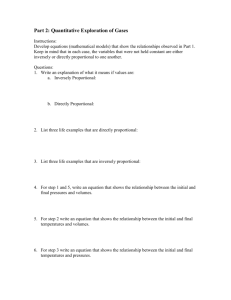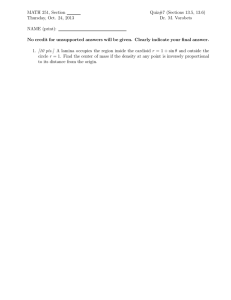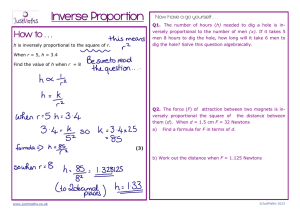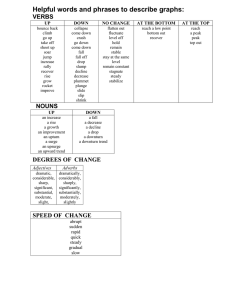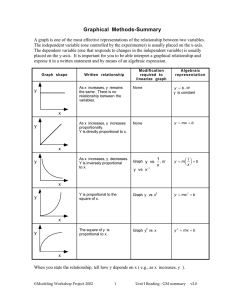Math 122 – Quiz IV Revue 1. Express the statement as an equation
advertisement
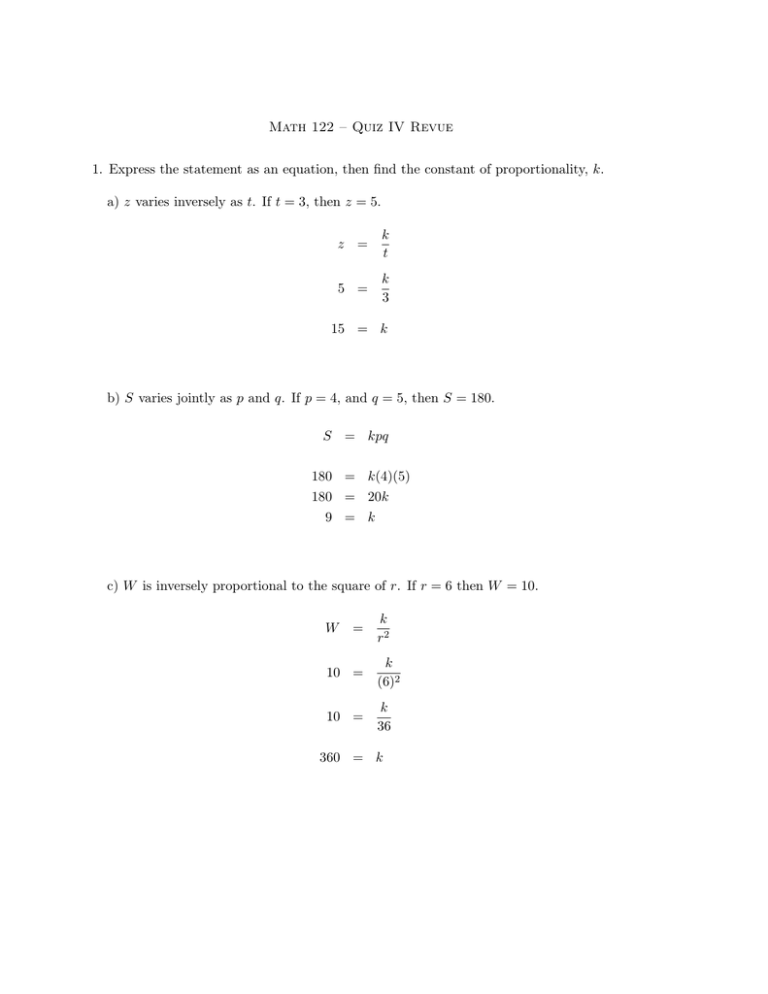
Math 122 – Quiz IV Revue 1. Express the statement as an equation, then find the constant of proportionality, k. a) z varies inversely as t. If t = 3, then z = 5. z = k t 5 = k 3 15 = k b) S varies jointly as p and q. If p = 4, and q = 5, then S = 180. S = kpq 180 = k(4)(5) 180 = 20k 9 = k c) W is inversely proportional to the square of r. If r = 6 then W = 10. W = k r2 10 = k (6)2 10 = k 36 360 = k 2 d) t is jointly proportional to x and y, and inversely proportional to r. If x = −1, y = 4 , and r = −2, then t = 14 t = k xy r 14 = k (−1)(4) −2 14 = k −4 −2 14 = k(2) 7 = k 2. The loudness L of a sound (measured in decibels, dB) is inversely proportional to the square of the distance d from the source of the sound. A person who is 10 ft from a lawn mower experiences a sound level of 70 dB. How loud is the lawn mower when the person is 100 ft away? k First we need our equation, which is L = 2 . Then we plug in d = 10 and L = 70, to d solve for k as follows: k L = d2 70 = k (10)2 70 = k 100 7000 = k Now that we have k, we can rewrite our equation with the value of k, and plug in d = 100. 7000 L = d2 L = 7000 (100)2 L = 0.7 dV 3 3. For each function, (i) find the domain, (ii) graph the function, and (iii) evaluate the function at x = −2, 0, 4. a) f (x) = 1 x−5 (i) Here, we can’t have the denominator equal zero, so we need to look at where x−5 6= 0, so x 6= 5. Thus, D : (−∞, 5) ∪ (5, ∞) (ii) 1 1 =− −2 − 5 7 1 1 f (0) = =− 0−5 5 1 1 f (2) = =− 2−5 3 (iii) f (−2) = b) g(x) = x2 + x + 8 (i) Since this is a polynomial, with no square root, and no fraction, we don’t have any problems for x. Thus D : (−∞, ∞) (iii) g(−2) = (−2)2 + (−2) + 8 = 4 − 2 + 8 = 10 g(0) = (0)2 + (0) + 8 = 8 g(2) = (2)2 + (2) + 8 = 4 + 2 + 8 = 14 4 (ii) c) h(x) = √ x−3 (i) Since we have a square root, we need the stuff inside the square root to be greater than or equal to zero. So we need x − 3 ≥ 0, or x ≥ 3. Therefore, we have D : [3, ∞) (ii) (iii) h(−2) = h(0) = h(2) = √ √ p (−2) − 3 = 0−3= 2−3= √ √ √ −5 −3 DNE −1 DNE DNE I didn’t mean for all of these to not exist...sorry it worked out like that...that won’t happen all the time. 5 4. Let f (x) = x2 + 1. Find each of the following and simplify if possible. (a) f (a) = (a)2 + 1 = a2 + 1 (b) f (a + h) = (a + h)2 + 1 = a2 + 2ah + h2 + 1 (c) f (a + h) − f (a) h = (a2 + 2ah + h2 + 1) − (a2 + 1) h = 2ah + h2 h = h(2a + h) h = 2a + h

